Fermented ginger honey is a deliciously sweet concoction with a nice ginger flavor that isn’t spicy at all. Ginger and honey are a tasty pair, and this fermented honey recipe is full of probiotics that support your wellness, along with some herbal ginger properties.
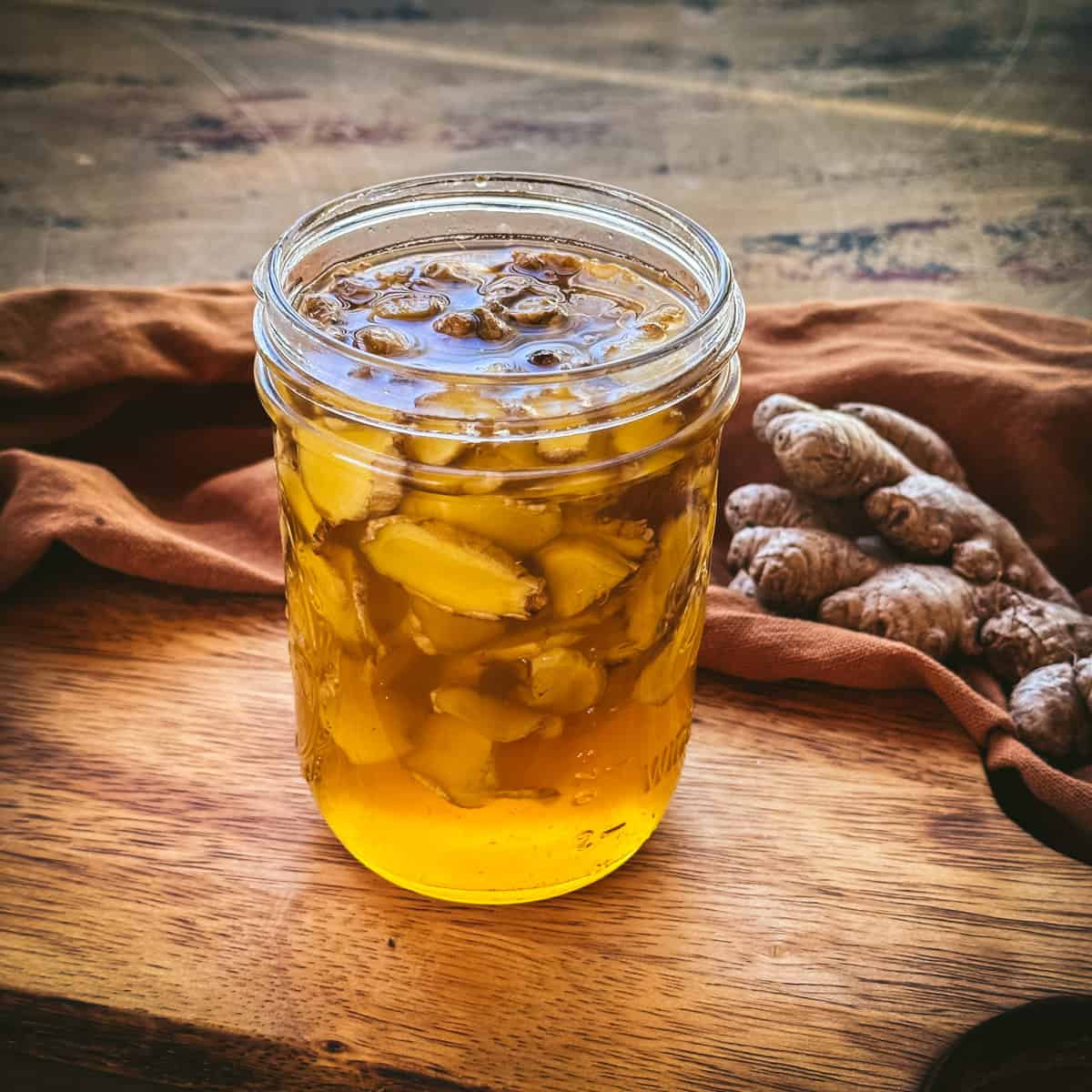
Want to save this post for later?
Ginger and Honey Herbal Uses
Fermented honey has long been studied and recognized to be good for you in various ways, particularly with the probiotics created by the fermentation process. There are also herbal properties, like those in fermented honey garlic, fermented elderberry honey, or lemon fermented honey. But in this case, ginger.
Ginger honey is good for general wellness, so take a spoonful whenever you need some herbal support. It can also help soothe an upset stomach, something ginger is well known for.
Although larger studies are needed for more specific functions, ginger has been effective in the majority of studies, demonstrating its benefits for various gastrointestinal and digestive functions, as well as anti-inflammatory effects.
In traditional herbalism, ginger is often used as a warming herb to support seasonal wellness. Combine this with raw honey and fermentation properties, and this is one powerful sweet treat!
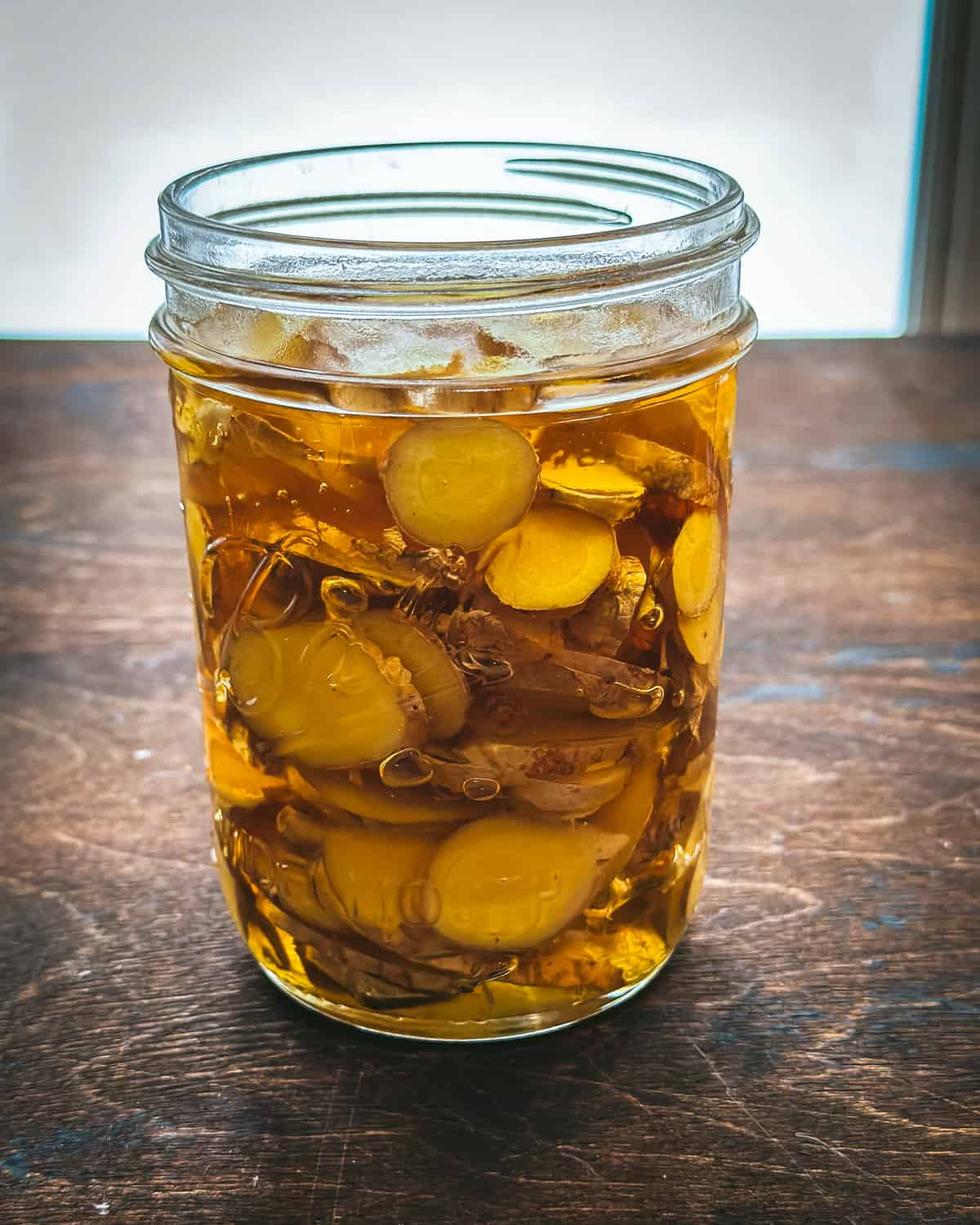
Ginger honey is perfect to have on hand for wellness support to ease stomach issues, digestion, and for daily seasonal health maintenance. You’ll want this in your kitchen wellness pantry all year round!
Fermented honey differs from infused honey, like this lilac-infused honey and this pine needle-infused honey. They take on the flavors and vitamins of the herbs but in a shorter process that doesn’t involve fermentation.
Get more winter wellness recipes for teas, infusions, syrups, honey ferments, oxymels, and gummies in my ebook Herbal Immune Support: Homemade Recipes for Wellness!
Fermented Ginger Honey Recipe
I didn’t peel the ginger for this recipe because there are natural yeasts on it that help the fermentation process — just like when I make a fermented ginger bug.
The finished honey tastes amazing! It’s sweet with a nice ginger flavor and isn’t spicy.
Ingredients
Fresh ginger: Use organic ginger, and as stated above, make sure to keep the skin on to help with fermentation. The small amount of juice from the sliced ginger will create just enough liquid for fermentation to happen.
Raw honey: It’s important to use raw honey because it has all the bacteria and wild yeast necessary for fermentation. Pasteurized honey may not ferment.
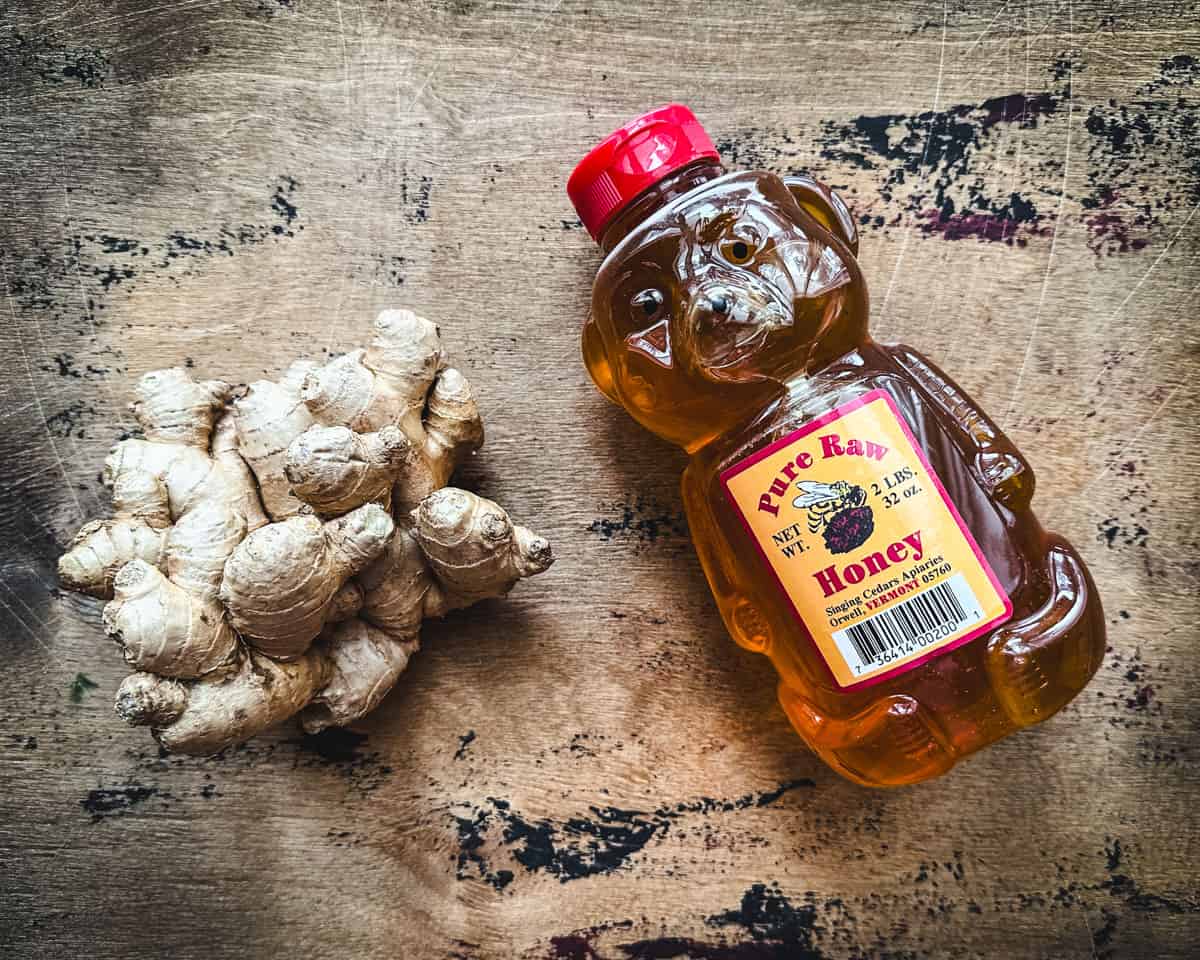
How to Make Fermented Ginger Honey
First, place the ginger slices into a wide-mouth pint-sized mason jar.

Then, add enough raw honey to cover the ginger slices completely, making sure they are all coated with honey.
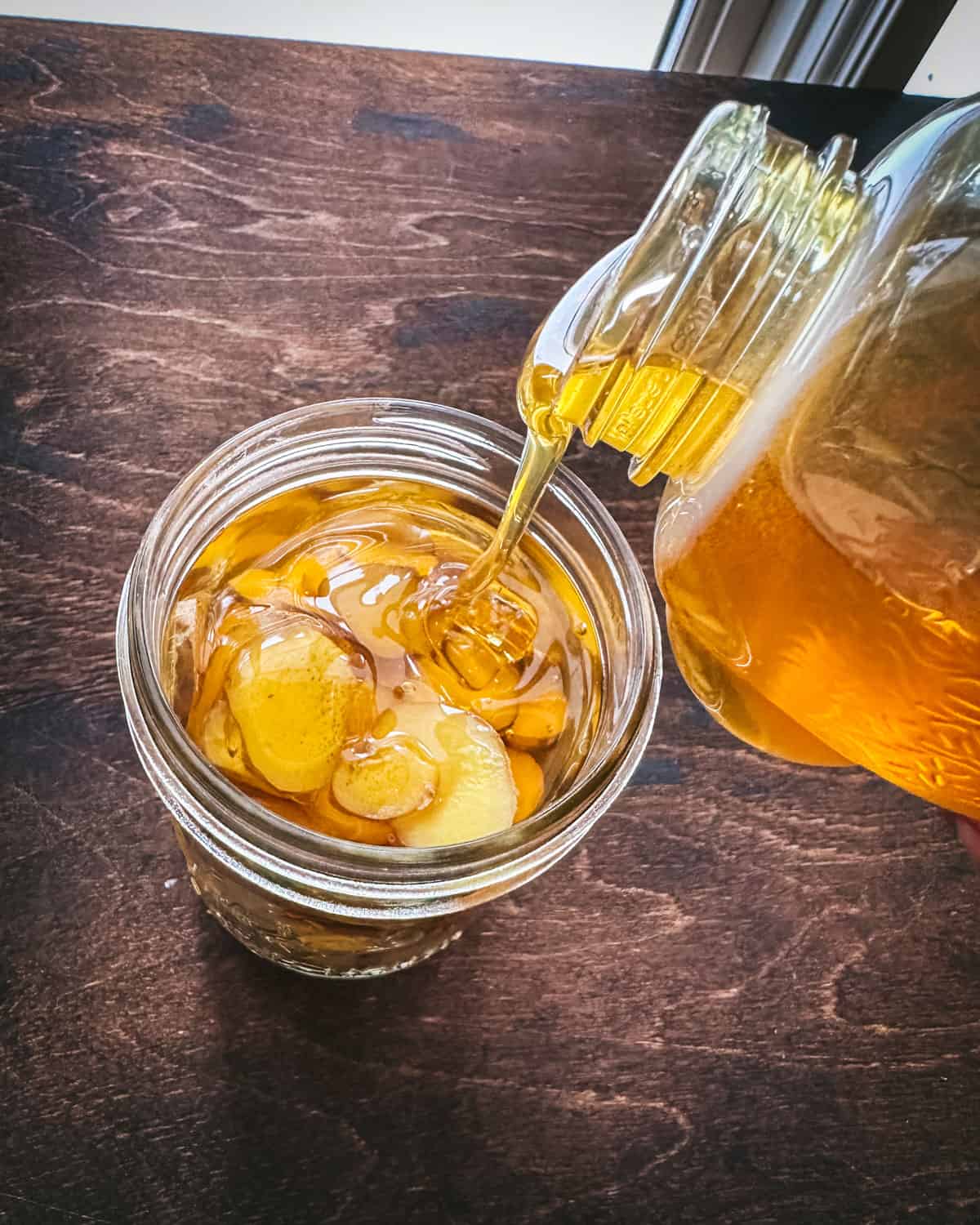
Cover the jar loosely with a lid in order to let any fermentation gases escape, then tuck it into a cool dark place out of direct sunlight.
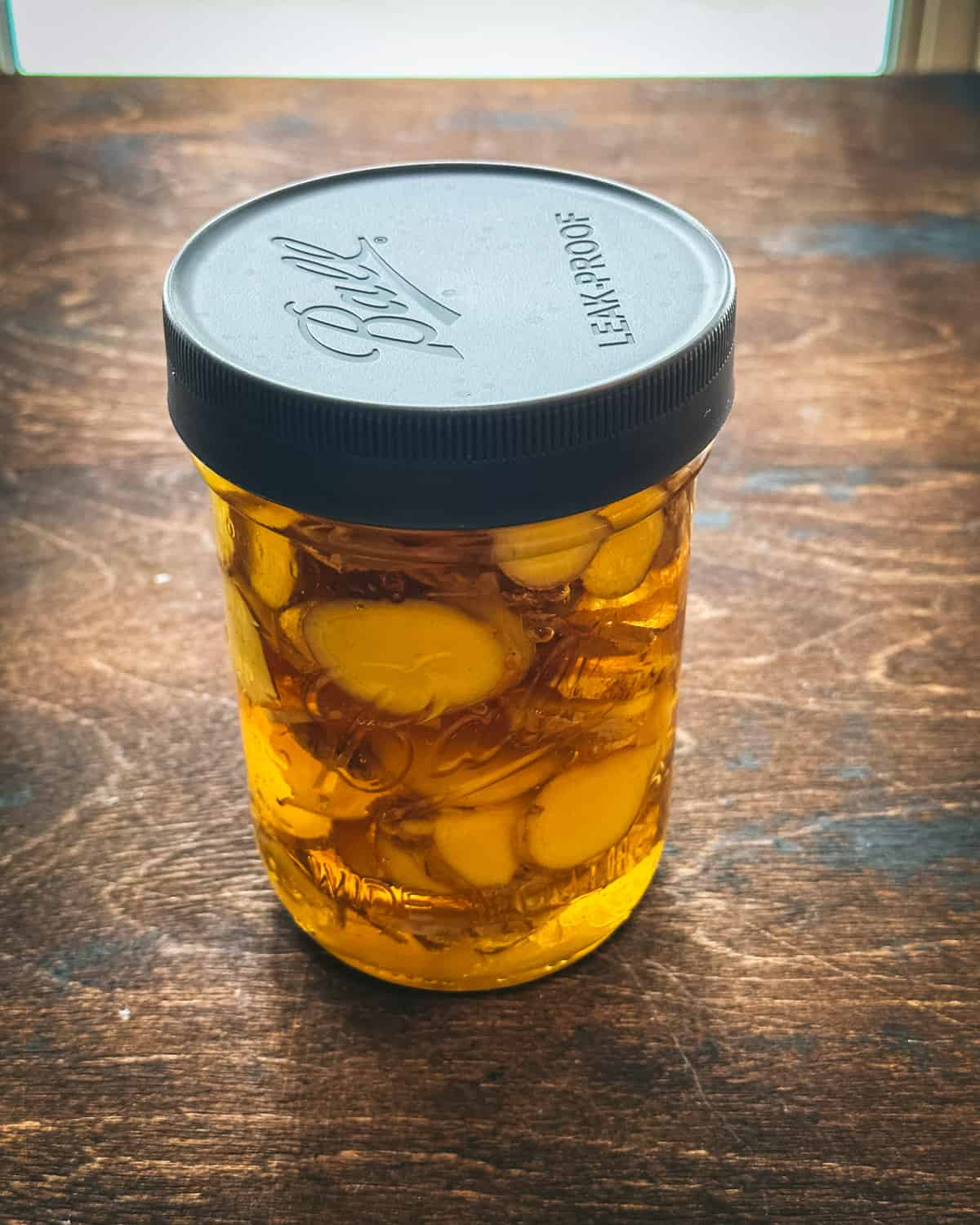
It’s a good idea to put a plate underneath the jar during fermentation, as it will likely bubble up and a little bit of honey might drip out.
Every day or so, tighten the lid on the jar and flip it upside down to coat the ginger slices with honey. Then loosen the lid again when you return it to the upright position.
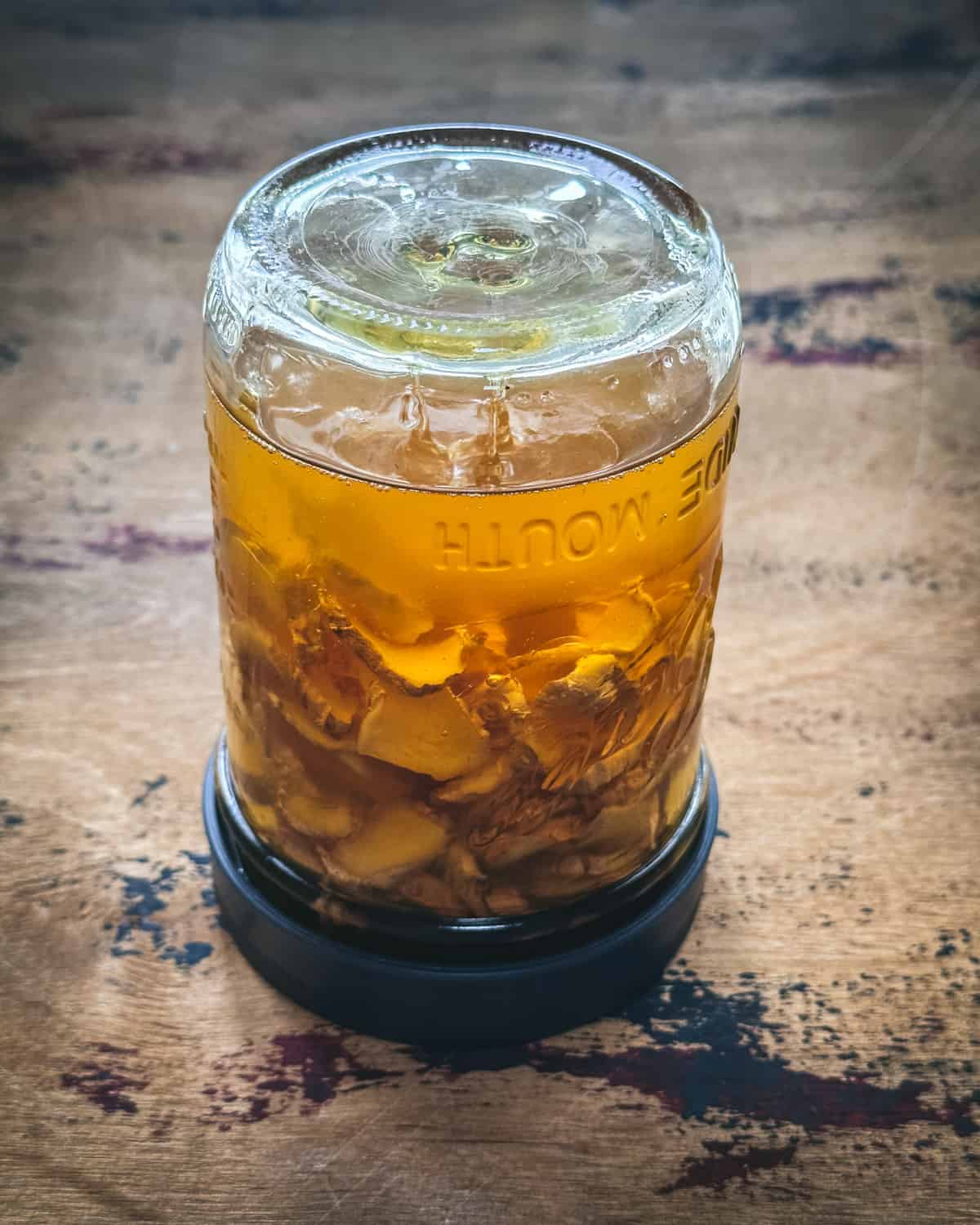
Within a few days to a week, you might start to see small bubbles start to form on the surface of the honey.
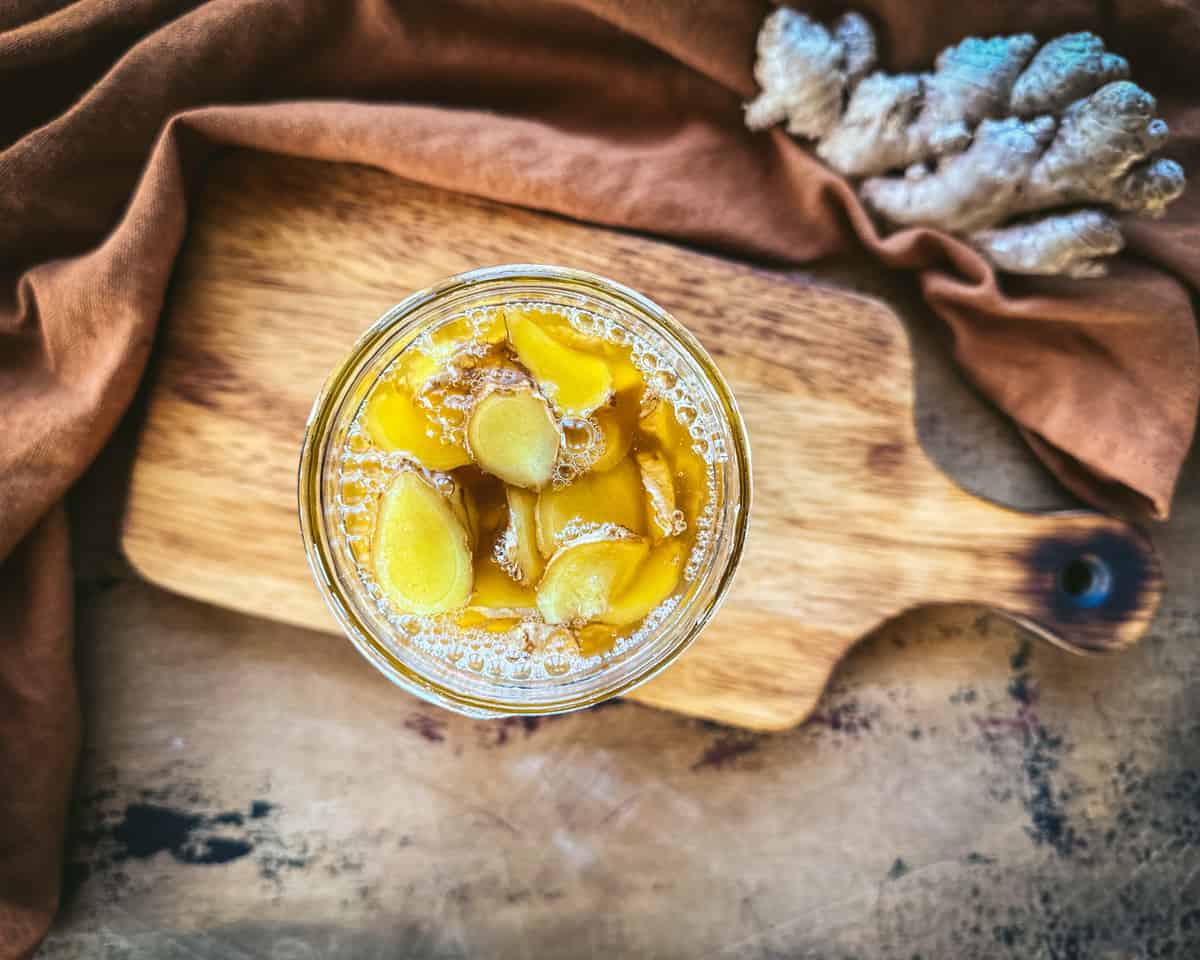
The ginger honey will ferment for about a month, but you can eat it at any time! The flavor will continue to develop the longer it ferments. The ginger spice will mellow, and the honey will become much runnier.
Uses and Storage
Fermented ginger honey is a deliciously drizzly, sweet, and ginger-y herbal treat without any spice. It’s delicious drizzled on a buttered English muffin, or used in a marinade or sauce.
Anywhere you might use ginger and honey together is a great place to use this honey ferment. Stir into tea, drizzle on yogurt, or just eat a spoonful for wellness!
The ginger is easy to eat, like a soft candied ginger. It’s perfect as an after-dinner refreshment to help with digestion.
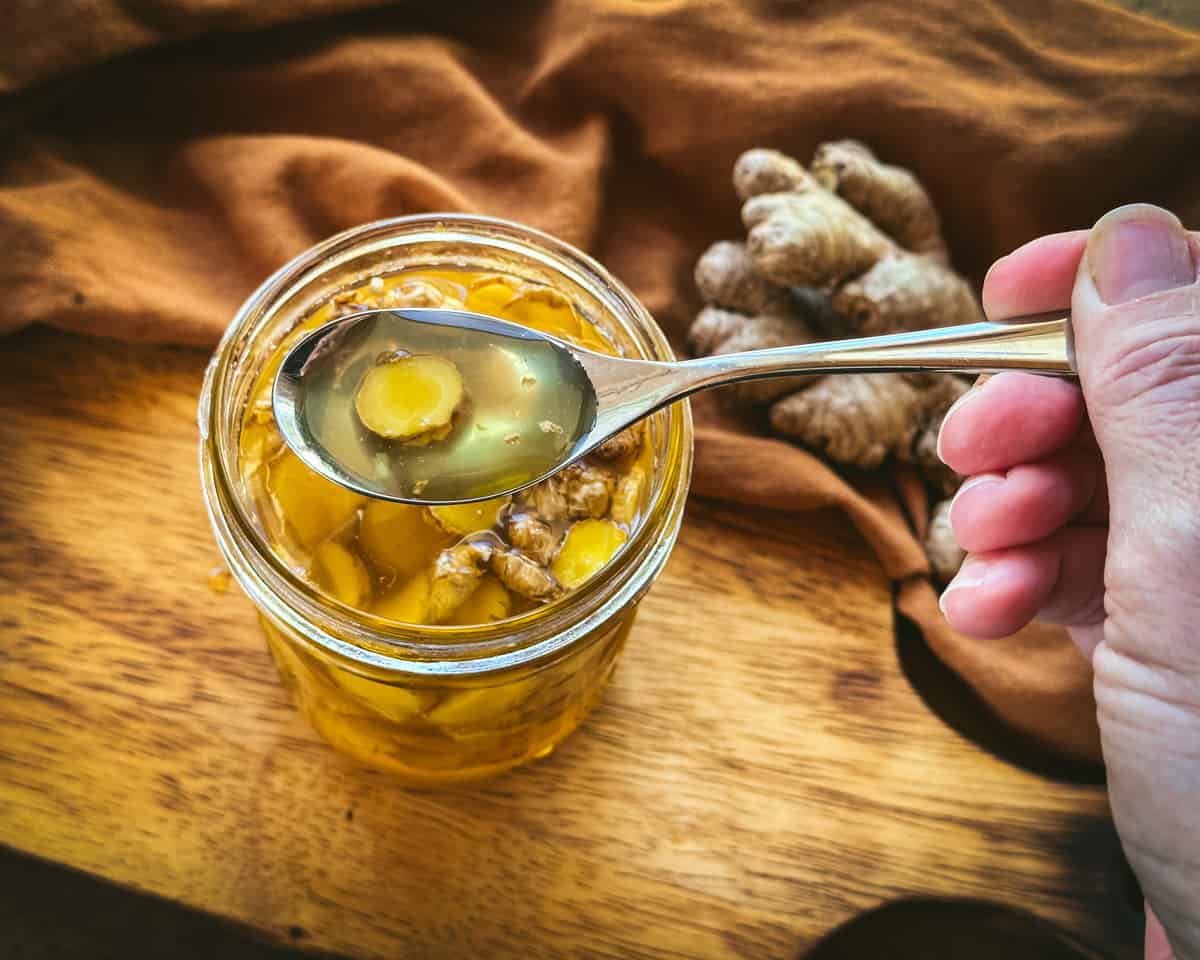
Store fermented ginger honey in a cool place, a dark kitchen corner, or a pantry works great. Refrigeration is ok, but it won’t continue to ferment and the honey might be less pliable.
It will be good for many months or even a year. Some honey ferments last even longer, I recommend a smell and taste check first.
Chances are, you’ll be drizzling the honey, chewing the ginger regularly, and making more before any length of time goes by!
Note: Infants under one year of age should not be given ginger honey due to the risk of botulism from raw honey. Studies suggest raw honey is safe for children over 12 months.
More Fermented Honey Recipes
- Fermented Elderberry Honey
- Fermented Honey Garlic
- Fermented Jalapeño Honey
- Fermented Honey Cranberries
- Fermented Honey Blueberries
- 8 Fermented Honey Recipes
Fermented Ginger Honey
Equipment
Ingredients
- 1 cup fresh ginger slices with skin on
- 1 cup raw honey or more, as needed to cover ginger
Instructions
- Place the ginger slices into a wide-mouth pint-sized mason jar. Add enough honey to cover the ginger completely. Make sure the slices are coated with honey.
- Place the lid on the jar loosely, then tuck it into a dark place.
- Every day or so, tighten the lid on the jar and flip it upside down to coat the ginger slices with honey. Loosen the lid again when you return it to the upright position.
- Within a few days to a week, you should see small bubbles start to form on the surface of the honey.
- The ginger honey will ferment for about a month, but you can eat it at any time. The flavor will continue to develop over time, the ginger spice will mellow, and the honey will become much runnier.
- Store in a cool place for many months or even a year, if not longer.
Notes
- It’s important to use raw honey for this recipe, as it has all of the bacteria and wild yeast that are necessary for fermentation.
- The small amount of juice from the ginger will create just enough liquid for fermentation to happen.
- It’s a good idea to put a plate underneath the jar during fermentation, as it will likely bubble up, and a little bit of honey could possibly drip out.
- If you are concerned about botulism, use a pH test strip. Botulism spores can’t reproduce with a pH of less than 4.6. Honey is usually around 3.9, but that can vary between brands.
- If the pH is too high, add a splash of raw apple cider vinegar to add more acidity and retest. This is generally not needed, but I do want to mention it.
- Ginger honey should not be given to babies under one year of age.

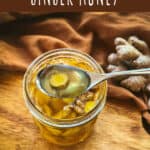
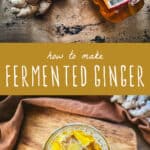
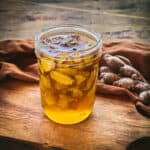

Hi! So I did my ferment but my basement is cool and I peeled so it bubbled barely but didn’t kept bubbling. Had a fermentation lid on it using peeled ginger and raw honey. So about 4-5 weeks later I tasted and it was yummy but the slightest alcohol scent, didn’t upset my stomach tho. So I put a sealed lid and loved it to a cupboard on the main kitchen and it seems to be fermenting again! It’s bubbly and I’ve had to burp it. I’m not sure where I’m at with this thing lol thoughts? It still looks crisp and clean, just small bubbles now.
If it’s still bubbling, it’s still fermenting, so I would keep burping it until it finally stops.
Hi I am new to ginger concoctions. I started with organic ginger washed and pealed than boiled the ginger for a while.I poured in clean jars poured about 1/3 honey in jars..I left the jars on the counter for several days.. I opened the jars and the mixture was very thick and had big slimy fermented stuff on top. ,It smells good no mold. I did mix a 1/2 with water and drank it. It tasted good just thick. I refrigerated the jars. Is this safe to drink. I wish I had seen the above recipe fist. I am going yo try above recipe. do you refrigerate after all done ? Thanks for help Betty
Hi Betty. Honey is shelf stable, it should never be refrigerated. I like to store mine in a cool, dark cabinet away from direct sunlight. I’m confused, did you already mix it with water? If so, because of the excess moisture, it’ll keep fermenting into alcohol. I would probably refrigerate it and use it within a week or two in sparkling water or as a marinade for meat and vegetables.
Hi. I have tried this recipe, with organic ginger and raw honey. It bubbled for only about a week, and it smells fantastic. However, I am now getting small spots of blue mould on the surface, which I have regularly been removing, but it still keeps coming back. What can I do to stop the mould? I’m reluctant to put it in the fridge as I suspect that the honey will harden. Any ideas?
P.S. I made a batch of honey fermented garlic, and I did not have this problem.
Hi Nicolas. Personally, I would just toss it. Either your honey or ginger was contaminated at the start or ginger was left exposed to air above the honey and it caused mold.
I peeled the ginger (and turmeric) because we don’t have access to organic here where we are in Peru. It hasn’t bubbled and doesn’t taste fermented after 10 + days. Is this dangerous to consume? I hadn’t read the part about botulism until now. Thank you, I love all your posts!
Hi Athena. It should still be safe. The worst case scenario is that you now have ginger infused honey instead of fermented honey.
I tried this but after about two weeks, the honey was extremely runny and it was smelling alcoholic which I don’t think is what we’re going for right? Did I do something wrong? Is a ginger honey infusion more fool-proof and safer to make than the fermented version? I’m hoping to make something with a wonderful locally produced raw honey as Christmas presents for our teachers but also want to make sure I don’t make any of them sick! ;-)
Hi Jenny. It sounds like the fermentation process might have gone a bit too far with your honey and ginger, leading to that alcoholic scent. This can happen if the mixture is kept in a warm environment or isn’t sealed properly after fermentation is already complete. Were there still consistent bubbles coming up to the top after two weeks? Once the bubbles stop completely, it’s best to close the lid and store in the pantry.
Switching to a ginger honey infusion is a great idea. This method involves simply mixing dried or candied ginger with honey and allowing it to sit for a few weeks. Without the moisture of the fresh ginger, it won’t ferment, which should give you a stable and flavorful product.
Thanks so much for your reply! I really appreciate it.
I never noticed many bubbles, just a clear change in the consistency of the honey. I will try it with the dried ginger to be on the safe side with my gift giving.
I hope you don’t mind me asking a couple of follow up questions.
I’m looking online how to dry ginger and all the recipes involve a dehydrator, which I haven’t got. Would it work to use a low heat setting on my oven as well?
And might you know – would the dried ginger become candied in the honey like the fresh ginger in the original recipe? I’m wondering if I should keep it in the honey that I gift, or remove it before gifting.
Thanks again for your support and your wonderful recipes and ideas!
Absolutely, you can dry ginger in your oven! Just set it to the lowest heat, around 150-200°F, and keep the door slightly open. Thinly slice the ginger and lay it on a baking sheet. It’ll take a few hours, so keep an eye on it.
As for adding it to honey, dried ginger won’t become candied but will flavor the honey nicely. You can choose to leave the ginger slices in the honey for a stronger flavor or take them out before gifting, it’s up to you!
Hi Colleen. I see that you have a fermented ginger recipe as well. I love to eat fresh garlic and fresh ginger. How can I combine the two together in the jar with the honey to get the extra benefits or is that not a good idea? Should they stay separate?
Yes, just add however much ginger and garlic to a jar, top with honey, and ferment!
I’ve been fermenting mine for maybe a month now and have a question. Can I add fresh chamomile flowers to the ferment?
Yes, that should be fine. I would probably put the chamomile flowers in a separate jar and pour the honey over it. That way, if you don’t like the flavor or something goes wrong during fermentation, you won’t lose your entire batch.
We received a boon of organic ginger and I can’t wait to try a honey ferment.
Can I use the final product of honey fermented ginger in a pop top to make sodas as well?
Thank you!
I haven’t tried, but you should be able to use the fermented ginger honey in place of a ginger bug in a fermented sodas. I haven’t tried it though, so I would maybe start by adding a little fermented ginger at a time to your liquid and see how it ferments.
I’m excited to follow your recipe. Thing is, I’m not sure if the ginger I’m buying here is organic so I need to ask, can I still used peeled ginger, without skin for this recipe?
You could try, but there’s no guarantee it’ll ferment. You really need the wild yeast on the skin to kickstart fermentation. Worst case scenario, you end up with ginger infused honey, which isn’t really a bad thing to have!
Because my husband is asking and I don’t know what tell him ;-) What is the difference between an infusion and fermentation? I know that yeast is involved in fermentation, but that’s about all I could tell him! In terms of the end product, will it be different in taste, consistency, nutritional content, etc?
Dried herbs, fruit, etc. are used in an infusion. Because no moisture enters the honey, just the dried foodstuff, only the flavor will be infused in the honey. When moisture of an herb, fruit, etc. is added to honey, that liquid will be released into the honey, causing fermentation to take place.
I have your herbal recipe book, yet I so enjoy reading and creating from your emails as well 😄🌱🪴🌾